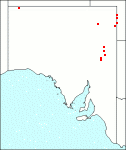Family: Fabaceae
Rhynchosia minima
Citation:
DC., Prod. 2:385 (1825).
Synonymy: Dolichos minimus L., Sp. Pl. 726 (1753).
Common name: Rhynchosia, rhyncho.
Description:
Perennial climbing or prostrate herb with several branching angular stems 0.15-50 cm (in S.Aust.) to several metres long from a woody branched rootstock, glabrous to velvety, with more or less sprinkled glandular dots; leaves alternate, variable, 2-10 cm long, on petioles 7-60 mm long; leaflets 3, rhomboid, ovate or suborbicular, 1-3 cm long and usually broader than long, acute or rounded at the apex, cuneate, rounded or truncate at the base, glabrescent to velvety, densely gland-dotted beneath, the laterals on c. 1 mm long petiolules, the terminal one on a distinct 2-20 mm long petiolule; stipules narrow-triangular, c. 2 mm long, scarious; stipels filiform, c. 1 mm long, green.
Inflorescence an axillary rather lax erect raceme, 2-10 cm long, longer than the subtending leaves, with 2-15 scattered flowers; flowers 5-11 mm long, on pedicels 1-1.5 mm; bract triangular, c. 2 x 0.5-1 mm, scarious, deciduous; calyx obconical, 4-5 mm long, pubescent, gland-dotted; teeth triangular to lanceolate, longer than the tube, upper 2 united for more of their length; standard suborbicular to obovate-cuneate, slightly longer than wide, on a long claw, sparsely pubescent on the back, with or without slightly raised calli at the base, yellow, streaked with purple, glandular-dotted, usually conduplicate over the wings and keel, rarely erect; wings narrow-obovate, shorter than the standard, yellow, auriculate, glandular-dotted; keel nearly as long as the standard, obovate, incurved, greenish-yellow; ovary pubescent, 2-ovulate.
Pod semicircular-falcate to oblong-ovate, 6-20 x 3-5 mm, glabrescent to densely pubescent, often with longer hairs, gland-dotted, beak 0.5-1 mm, 1- or 2-seeded; seed reniform-ovate, 3-4 x 2-3 mm, compressed, greyish, brown, black or mottled, smooth; hilum ovate, 0.5-1 mm, aril lobes cuneate.
Published illustration:
Cunningham et al. (1982) Plants of western New South Wales, p. 411.
|
|
Distribution:
|
Grows in various habitats, primarily as a weed in waste places and cultivated land.
S.Aust.: NW, LE, FR. W.Aust.; N.T.; Qld; N.S.W. in warmer parts of America; Africa; southern Asia; Melanesia; Timor.
|
Conservation status:
native
Flowering time: spring — summer.
|

SA Distribution Map based
on current data relating to
specimens held in the
State Herbarium of South Australia
|
Biology:
The plant is said to be injurious to grazing cattle.
Taxonomic notes:
Very variable species divided into several infraspecific taxa, but R. D. Meikle (1958) p. 555 failed to find really workable characters to subdivide this complex, in which perhaps may be included R. australis Benth. (1864), as a large-flowered form. The flowers and fruits are remarkably stable in their characters.
Author:
Not yet available
|

